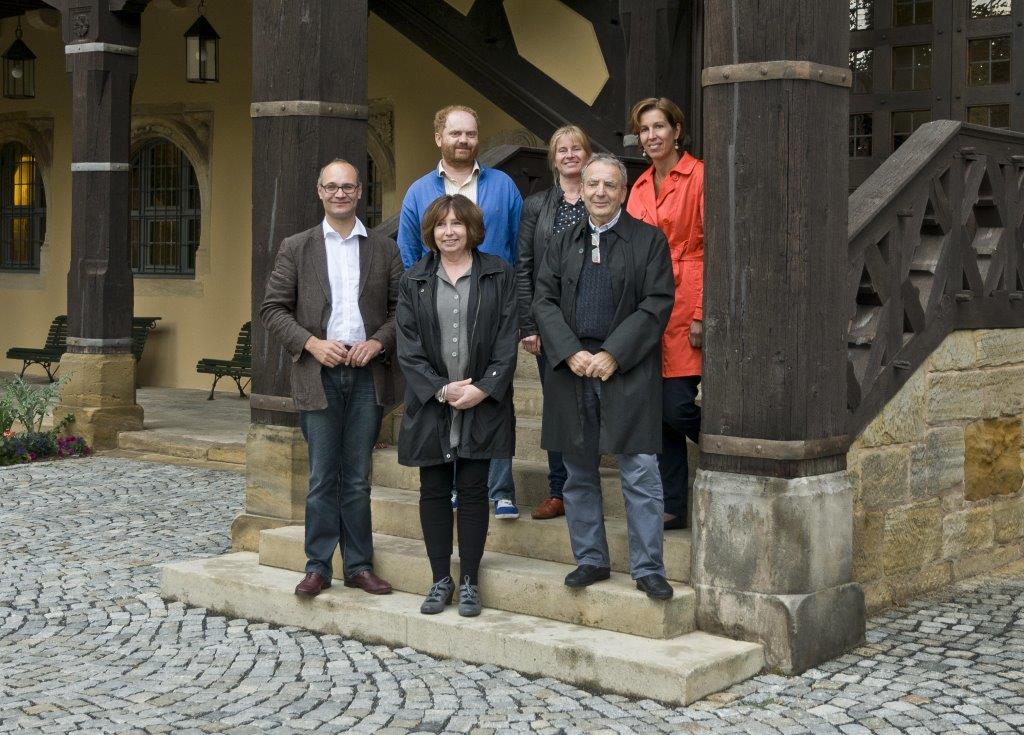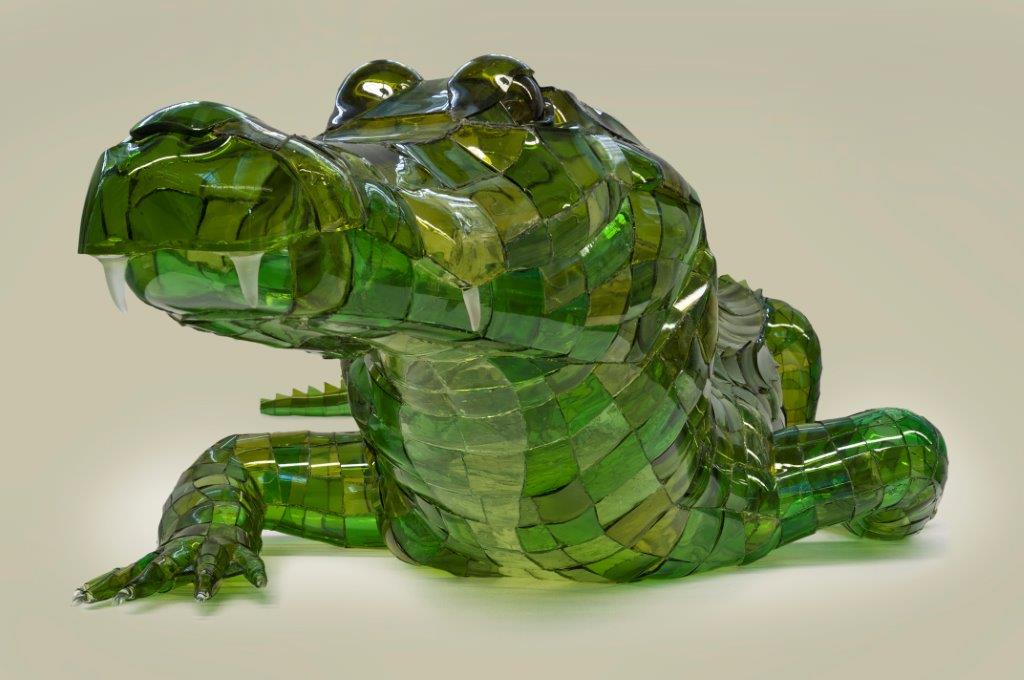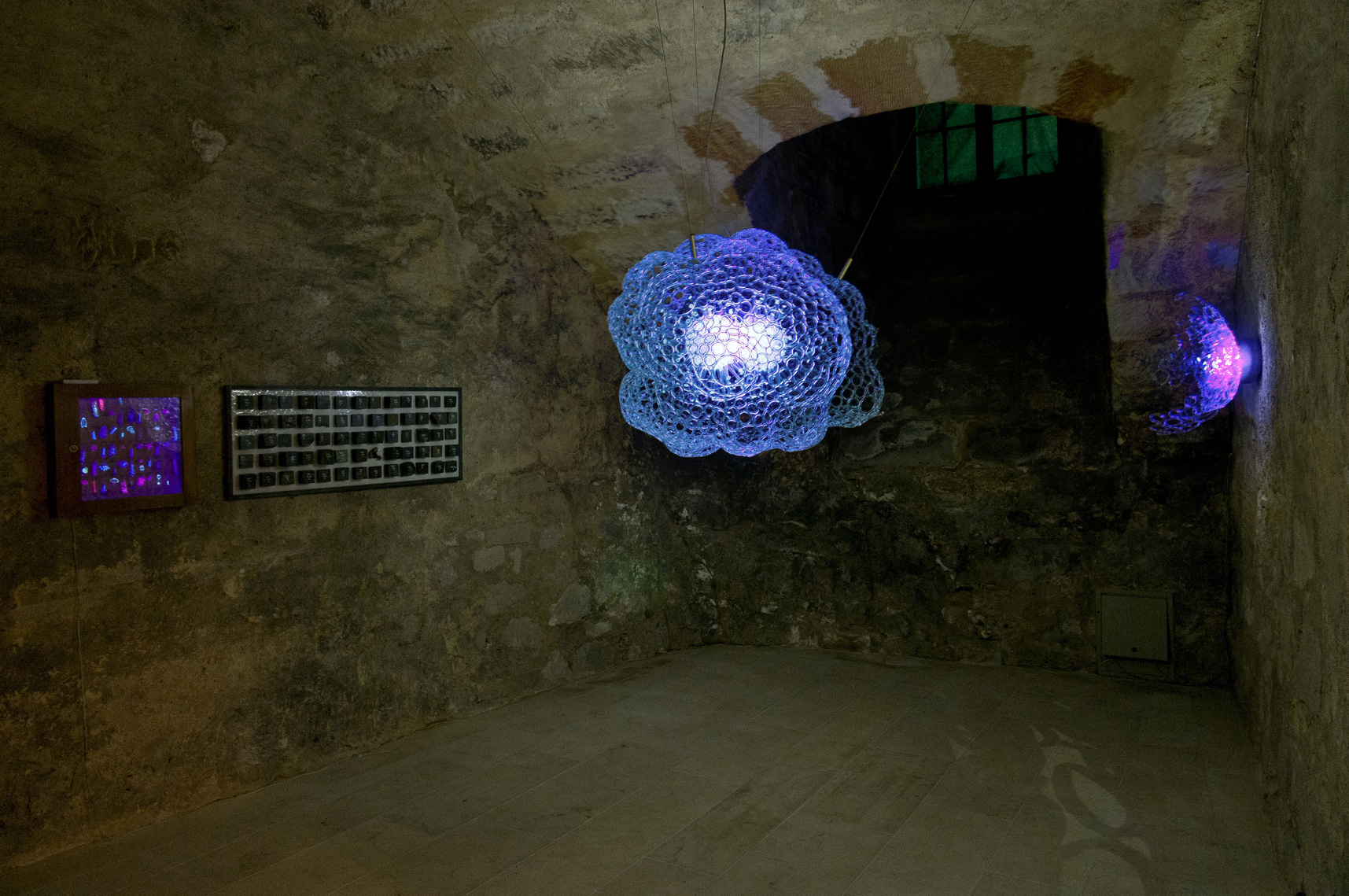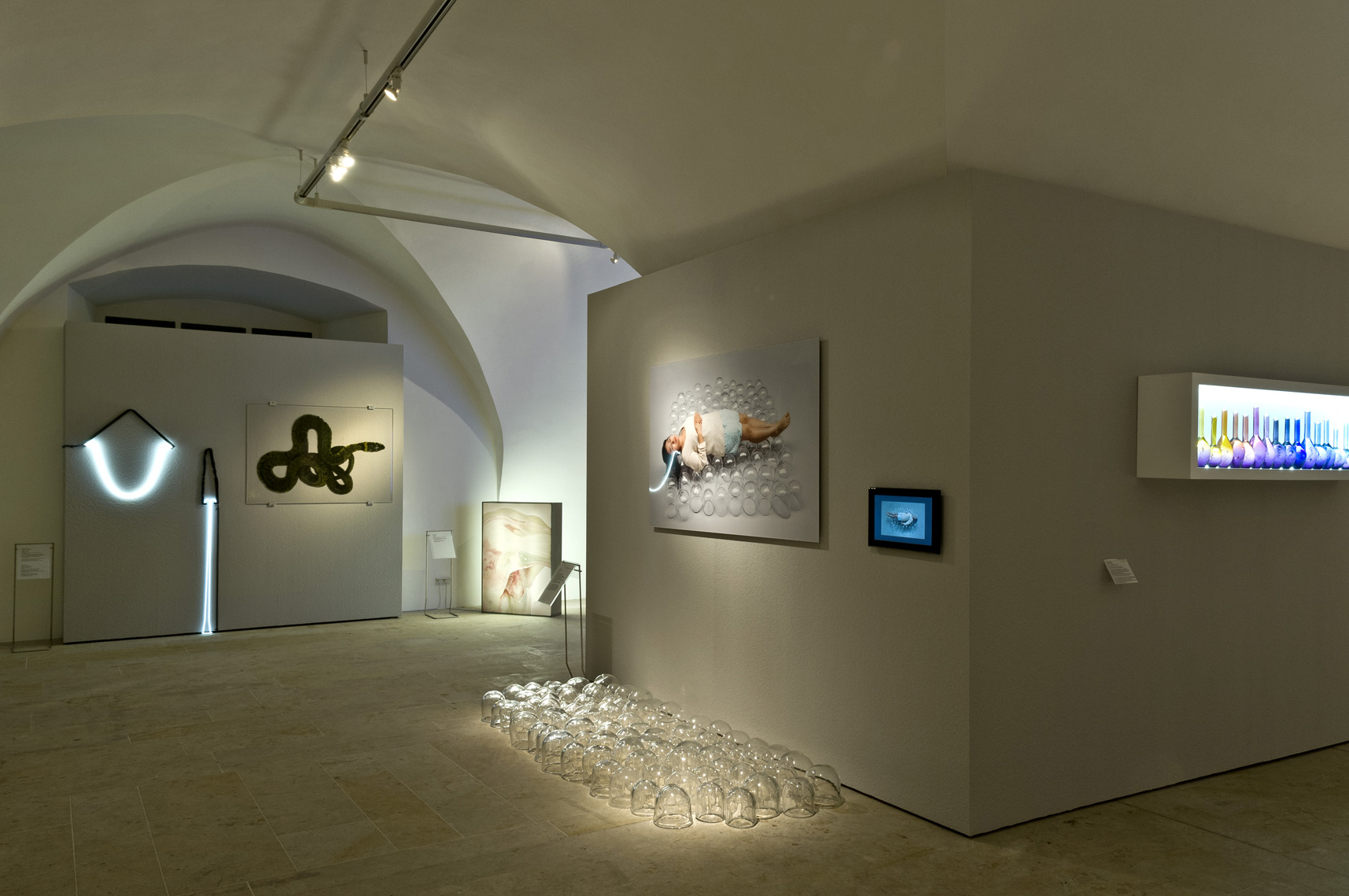Die lange Schnauze neugierig erhoben, fast majestätisch und mit weit geöffneten Augen erwartet der „Eco Jacaré“ (Öko-Cayman) von Bert van Ransbeeck die Besucher der Ausstellung des 4. Coburger Glaspreises in den Kunstsammlungen der Veste Coburg. Das aus recyceltem grünem Flaschenglas in dreijähriger Arbeit entstandene Tier wechselt je nach Lichteinfall und je nach Standpunkt des Betrachters seine Hautfarbe. Dieser Eye Catcher am Ausstellungseingang und einprägsame Werbeträger verspricht weitere tierische Entdeckungen, weitere faszinierende Kunstwerke aus Glas.

Glaspreis-Jury Coburg (Sven Hauschke, Milan Hlaves, Susanne Joker-Johnson, Anne Vanlatum, Jutta Page, Peter Layton)
Der Coburger Glaspreis wird 2014 zum vierten Mal verliehen. Mehr als 550 europäische Künstler haben sich darum beworben. Die international besetzte Jury begutachtete 1150 per Foto eingereichte Werke aus den Jahren 2012 und 2013. 150 Künstler wurden schließlich eingeladen. Drei hoch dotierte Hauptpreise und acht Sonderpreise konnten nach einer zweiten Jury-Runde vergeben werden; ein Publikumspreis wird am Ende der Ausstellungslaufzeit verliehen.
Die Ausstellung ist eine Gesamtschau über zeitgenössisches Glas in Europa. Vertreten sind vor allem junge Künstler, wie Anna Mlasowsky, Tim Rawlinson, Andrej Jančovič oder Robyn Townsend, aber auch etablierte, wie Keith Cummings, Colin Reid oder René Roubíček. Der jüngste Teilnehmer wurde 1989 geboren, der älteste 1922. Diese Mischung ermöglicht einen Querschnitt durch die zeitgenössische Glaskunst. Sichtbar ist dies in der Vielfalt künstlerischer Äußerungen – es gibt Skulpturen, Glasbilder, Installationen, Leuchtobjekte, Mixed Media und Video Kunst. Auch technisch wird ein breites Spektrum geboten. Die Gruppierung der Werke nach inhaltlichen und technischen Aspekten erlaubt einen spannenden Rundgang durch die weitläufigen historischen Räume der Veste Coburg. Insgesamt sind über 1000 m² Fläche bespielt, davon 200 m² Ausstellungsfläche im Europäischen Museum für Modernes Glas in Rödental.
Das Renommee des Coburger Glaspreises ist groß. Seit seiner mutigen Initiierung 1977 durch den damaligen Direktor der Kunstsammlungen der Veste Coburg, Heino Maedebach, als erster Wettbewerb für modernes Glas in Europa, hat sich der Coburger Glaspreis zu einer festen Größe in der Glaskunstszene entwickelt, auch wenn es weitere renommierte Preise und Wettbewerbe gibt, was wiederum den großen zeitlichen Abstand zwischen dem zweiten und dritten Coburger Glaspreis 1985 und 2006 erklärt. Die große Resonanz von Seiten der Künstler und die weitreichende Wirkung in Besucher- und Fachkreisen sprechen dabei für sich. Thematische Vorgaben hat es bei dem Wettbewerb 2014 nicht gegeben. Die Teilnahme ist für Künstler Ansporn und Ermutigung, sich künstlerisch mit dem Werkstoff Glas auseinanderzusetzen, bedeutet aber auch einen großen zeitlichen und finanziellen Aufwand. Von der Bewerbung bis zur Preisverleihung sind 15 Monate vergangen. Die Transportkosten, Hin und Zurück, für ihre Kunstwerke müssen die Künstler selbst tragen. Die Vergangenheit hat gezeigt, dass der Coburger Glaspreis für Preisträger und Teilnehmende ein wichtiger Schritt in der künstlerischen Karriere sein kann.
Dr. Sven Hauschke, Kurator, Jurymitglied und Leiter des Europäischen Museums für Modernes Glas, erläutert die Hintergründe des Coburger Glaspreises 2014:
Dr. Meike Leyde: 170 Werke von 150 Künstlern aus 26 Ländern werden auf einer Gesamtfläche von gut 1000 m² gezeigt. Worin liegen die Herausforderungen einer solchen Präsentation?
Dr. Sven Hauschke: Beim Wettbewerb zum Coburger Glaspreis 2014 gab es keine formalen, technischen oder inhaltlichen Einschränkungen. Alle professionell tätigen Künstler, die in Europa geboren sind oder hier leben und die mit Glas arbeiten, konnten sich bewerben. Deshalb haben, anders als bei einer thematischen Ausstellung, die eingereichten Werke zunächst nichts miteinander zu tun. Die größte Herausforderung besteht darin, aus den 170 Einzelobjekten eine Ausstellung zu machen, Bezüge herzustellen und dem Besucher übergreifende Gruppen zu präsentieren, bei denen größere Zusammenhänge sichtbar werden.
ML Was zeichnet den Coburger Glaspreis 2014 aus? Was unterscheidet ihn von anderen Preisen wie dem European Glass Context?
SH Der Coburger Glaspreis ist zahlenmäßig und auch vom organisatorischen Aufwand der größte Wettbewerb im Bereich Glas. Beim European Glass Context auf Bornholm können sich Künstler nicht selbst bewerben. Vielmehr schlagen für jedes europäische Land sogenannte nationale Commissioner in zwei Kategorien – Nachwuchskünstler und etablierte Künstler – jeweils vier Künstler vor, aus denen eine Jury maximal zwei Vertreter auswählt. Bei dem zuletzt 2012 ausgerichteten Wettbewerb wurden 96 Künstler aus 28 Ländern präsentiert.
Der Coburger Wettbewerb ist offen, die Künstler bewerben sich selber. Damit erzielen wir eine möglichst große Bandbreite an eingereichten Objekten. Gegebenermaßen ist dann auch die Auswahl weitaus schwieriger. So mussten wir ungefähr 400 Künstlern leider eine Absage schicken.
ML Nach dem 2. Coburger Glaspreis 1985 wurde das Europäische Museum für Modernes Glas gegründet, im Jahr 1989 das erste Museum in Mitteleuropa für modernes Glas. Der 3. Coburger Glaspreis 2006 hatte den von Otto Waldrich initiierten und wesentlich finanzierten Museumsneubau von Alfred Wagner zur Folge. Wird der 4. Coburger Glaspreis vergleichbare Impulse setzen? Welche Bedeutung hat er für das Europäische Museum für Modernes Glas und für die Stadt Coburg?
SH Die Kunstsammlungen der Veste Coburg und damit auch die Stadt Coburg haben mit dem Europäischen Museum für Modernes Glas eine einzigartige Einrichtung. In den 25 Jahren, in denen das Museum nun existiert, hat es sich wegen seiner Sammlung und den vielfältigen Sonderausstellungen als Anlaufstelle für Besucher und Künstler etabliert. Wir erhalten Anfragen aus der ganzen Welt. Nicht nur in Fachkreisen verbindet man mit Coburg das Moderne Glas und sein Museum, wozu vor allem der Coburger Glaspreis als innovativer Wettbewerb seinen Beitrag leistet. Als besondere Auszeichnung werten wir es, dass zur Eröffnung des Coburger Glaspreises allein über 100 Künstler ihr Kommen angekündigt haben.
ML Schaut man nach der Herkunft der einzelnen Künstler, so fällt auf, dass britische und deutsche Künstler zahlreich vertreten sind, während beispielsweise Niederländer oder Italiener weniger häufig sind. Woran liegt das?
SH Die Niederlande sind natürlich ein kleineres Land als Deutschland oder Großbritannien. Grundsätzlich sind diejenigen Länder stark vertreten, in denen es gute, breitgefächerte und innovative Ausbildungsmöglichkeiten gibt. Da sind vor allem Großbritannien, die Tschechische Republik, Dänemark, Frankreich, die Slowakei, aber auch die Niederlande mit der Gerrit Rietveld Academie zu nennen. Italien spielt trotz der historischen Tradition bei der Glasherstellung kaum eine Rolle mehr. Allerdings droht auch Deutschland aufgrund teilweise extremer finanzieller Einsparungen bei der Ausbildung im internationalen Wettbewerb den Anschluss zu verlieren. Dies spiegelt sich auch bei den Ausstellerzahlen beim Glaspreis wider: Während 2006 noch 44 Künstler aus der Bundesrepublik, 27 aus der Tschechischen Republik, 7 aus der Slowakei und 18 aus Großbritannien stammten, kommen beim Coburger Glaspreis 2014 nun 42 Künstler aus dem Vereinigten Königreich, 29 aus Deutschland, 18 aus der Tschechischen Republik und 7 aus der Slowakei.
ML Den ersten Preis bekommt die dänische Künstlerin Karen Lise Krabbe. Sie schuf ein auffallend kleines, fragiles Pâte de Verre-Objekt, das – wenn auch versteckt – die traditionelle Gefäßform aufgreift. Was ist das Besondere, das Innovative an ihrer Arbeit?
SH Die Objekte von Karen Lise Krabbe sind Kunstkammerstücke. Nur im geöffneten Zustand sind sie als Dosen zu erkennen. Man glaubt, sie sind auf natürlichem Weg entstanden, wie durch Flut und Ebbe geformte Sandschichten. Tatsächlich werden die Dosen Schicht um Schicht in einer Sandform gegossen – ein manuelles Verfahren, dass dem Herstellungsprozess eines 3D-Druckers ähnelt. Die perfekt gearbeiteten Dosen üben eine ungeheuere Faszination aus. Trotz ihrer Fragilität und geringen Größe wirken sie keineswegs klein. Man kann sie sich auch ins Monumentale gesteigert vorstellen, als große, durch Erosion geformte Felsen. Karen Lise Krabbe spielt mit dem Werkstoff Glas, mit der Illusion einer natürlichen Entstehung, mit Form und Funktion sowie mit der Wahrnehmung des Betrachters. Ihr sind hochartifizielle Meisterwerke gelungen.
ML Der Coburger Glaspreis bietet eine einzigartige Möglichkeit, sich ein Bild von aktuellen Tendenzen und Strömungen in der Glaskunst zu machen. Blickt man zurück und vergleicht frühere Preisträger und deren Viten, so fällt auf, dass 1977 mit Ann Wärff eine ausgebildete Designerin den Preis bekam. Sie war Entwerferin in der Glasmanufaktur Kosta Boda. 2006 ging dann der Preis an Josepha Gasch-Muche, die ausgebildete Graphikerin ist und das Material Glas zur Umsetzung ihrer Ideen nutzt. Welche Rolle spielen Glaskünstler und das Material Glas heute und welche Stellung hat die Glaskunst in der zeitgenössischen Kunst?
SH 1977 und auch noch 1985 wurden in Coburg beim Glaspreis viele Gefäße gezeigt, die häufig mundgeblasen waren und recht kleine Dimensionen besaßen. 2006 dominierten skulpturale Arbeiten. Heute, im Jahr 2014, fällt die große Vielfalt auf. Nicht nur hinsichtlich der verwendeten Techniken, sondern auch bezüglich der eingesetzten Materialien. Glas wird kombiniert mit Kunststoff, Papier, Schiefer, Beton, Edelmetallen, Stahl, Eisen, Kupfer, Holz, Keramik, Textilien und Tierpräparaten. Glas wird als Druckmedium eingesetzt und Photographie sowie Videotechnik gerieren mehrfach zum zentralen Medium. Ferner spielt Klang in zwei Performances eine entscheidende Rolle. Sozialgeschichte und Umweltaspekte sowie kulturgeschichtliche Fragen im Zeitalter der Globalisierung treten immer mehr in den Vordergrund. Es gibt kaum ein Werk, das neben seinem künstlerischen Wert nicht auch eine inhaltliche Aussage besitzt. Mit Glas werden Emotionen und Gefühle ausgedrückt.
Man kann festhalten, dass Künstler, die mit Glas arbeiten, vollständig aus dem – traditionell gesehen – kunsthandwerklichen Schatten getreten sind. Glas ist ein Material unter vielen, ein fester, nicht mehr weg zudenkender Bestandteil der zeitgenössischen Kunst. Dies wollen wir mit dem Coburger Glaspreis 2014 heraus streichen.
ML Was ist Ihr persönliches Lieblingsobjekt des Coburger Glaspreises 2014?
SH In dem knappen Jahr der Vorbereitung und davon gut sieben intensiven Monaten befasst man sich sukzessive mit allen auszustellenden Werken, insbesondere bei der Herstellung des Katalogs. In dieser Zeit wechseln die Favoriten zwangsläufig. So gibt es auch nicht ein Lieblingsobjekt, sondern eine ganze Serie. Wir zeigen in Coburg viele Objekte, die teils starke Emotionen auslösen können – das berührt einen immer auch persönlich.
Ich bin in der glücklichen Lage, unter den ausgestellten Objekten für die Coburger Glassammlung nicht nur ein einziges Werk, sondern mehrere erwerben zu können. Da muss man sich nicht auf ein Lieblingsobjekt festlegen.
Dr. Meike Leyde, Kunsthistorikerin, arbeitet bei den Museen der Stadt Bamberg, lebt in Coburg.
Bert van Ransbeeck (Belgium): Öko-Caiman / Eco Jacaré, 240 x 120 cm
Coburg Maskottchen



